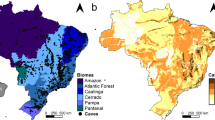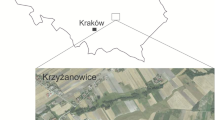Abstract
Termites, being serious pests of sugarcane, have been posing threat to its cultivation in Indo-Gangetic plains of North-West zone of India. Monthly observations round the year revealed a highest per cent incidence of termites in the month of August to the tune of 25.45% followed by 22.73, 21.82, 18.18 and 15.45% in the months of July, September, October and June, respectively. The incidence was lower in winter months, i.e. January, February and March with 4.55, 5.45 and 7.27%, respectively. It is evident from the weather data that monsoon season with high relative humidity and moderate temperature was favourable for the build-up of the population of termites, while winter season was unfavourable. Study on relative abundance of different species of termites in sugarcane revealed that termite species, Odontotermes obesus, occupied the maximum percentage of occurrence to the tune of 28.57% followed by that was 21.42, 14.28, 14.28, 14.28 and 7.14% of Microtermes obesi, O. horni, O. vaishno, O. bellahunisensis and Odontotermes sp., respectively. Of the total species recorded during the course of study, three species, viz. Odontotermes horni (Wasmann), O. vaishno Bose and O. bellahunisensis Holmgren and Holmgren, were recorded for the first time to infest sugarcane in India. An illustrated key was developed for easy and quick identification of termite species collected from sugarcane. The study holds promise for strategic planning for the management of termites in sugarcane agro-ecosystem.






Similar content being viewed by others
References
Akhtar, M.S. 1974. Zoogeography of the termites of Pakistan. Pakistan Journal of Zoology 6(1–2): 85–104.
Avinash, T.G., and N.G. Kumar. 2019. Pest status and seasonal activity of termites in relation to abiotic factors in different field crops. Journal of Entomology and Zoology Studies 7(1): 1235–1239.
Bose, G. 1984. Termite fauna of Southern India. Records of the Zoological Survey of India 49: 1–270.
Chatterjee, P.N., and M.L. Thakur. 1967. Contributions to the knowledge of systematics of north-western Himalayan termite fauna (Isoptera: Insecta). III. Systematic account of the survey. Indian Forest Records Entomology 11(1): 1–57.
Chhotani, O.B. 1997. Fauna of India-Isoptera (Termites), vol. II. Calcutta: Zoological Survey of India.
David, H., and V. Nandagopal. 1986. Pests of sugarcane—Distribution, symptomatology of attack and identification. In Sugarcane entomology in India, ed. H. David, S. Easwaramoorthy, and R. Jayanthi, 1–29. Sugarcane Breeding Institute: Coimbatore.
Davies, R.G. 2002. Feeding group responses of a Neotropical termite assemblage to rain forest fragmentation. Oecologia 133: 233–242.
Gathorne-Hardy, F., Syaurani, and P. Eggleton. 2001. The effects of altitude and rainfall on the composition of the termites (Isoptera) of the Leuser Ecosystem (Sumatra, Indonesia). Journal of Tropical Ecology 17: 379–393.
Harris, W.V. 1969. Termites as pests of crop and tree. Tropical Pest Management 30(1): 41–48.
Hemachandra, E., K.Inoka Jayanthi, and C.V.S. Gunatilleke. 2012. An annotated checklist of termites (Isoptera) from Sri Lanka, 29p. Sri Lanka: National Science Foundation.
Jones, D.T., and P. Eggleton. 2011. Global biogeography of termites: A compilation of sources. In Biology of termites: A modern synthesis, ed. D.E. Bignell, Y. Roisin, and N. Lo, 477–517. Dordrecht: Springer. https://doi.org/10.1007/978-90-481-3977-4_17.
Junqueira, L.K., E.R. Gonçalves, and L.M.C. Teixeira. 2015. Termite communities in sugarcane plantations in South eastern Brazil: An ecological approach. EntomoBrasilis 8(2): 105–116.
Kalleshwaraswamy, C.M., D.K. Nagaraju, and C.A. Viraktamath. 2013. Illustrated identification key to common termite (Isoptera) genera of south India. Biosytematica 7(1): 11–21.
Krishna, K., D.A. Grimaldi, V. Krishna, and M.S. Engel. 2013. Treatise on the Isoptera of the world, Vol 4—Termitidae (part 1). Bulletin of American Museum of Natural History 377: 975–1494.
Mathew, J. 2015. Checklist and pest status of termites (order: Isoptera): Kerala. International Journal of Plant, Animal and Environmental Sciences. 5(2): 151–158.
Pardeshi, M.K., D. Kumar, and A.K. Bhattacharya. 2010. Termite (Insect: Isoptera) fauna of some agricultural crops of Vadodara, Gujarat (India). Records of the Zoological Survey of India 110(1): 47–59.
Rajagopal, D. 2002. Economically important termite species in India. Sociobiology 40(1): 33–46.
Roonwal, M.L. 1986. Termites of agricultural importance. In Agricultural entomology, vol. 2, ed. P.D. Srivastava, M.G. Jotwani, R.A. Agarwal, S.R. Wadhi, R.K. Bhanotar, and R.K. Bhatnagar, 23–35. New Delhi: All India Scientific Writers’ Society.
Roonwal, M.L., and O.B. Chhotani. 1989. The fauna of India and the adjacent countries-Isoptera (Termites). Calcutta: Zoological Survey of India.
Saha, N., P.C. Mazumdar, J. Basak, A. Raha, A. Majumder, and K. Chandra. 2016. Subterranean termite genus Odontotermes (Blattaria: Isoptera: Termitidae) from Chhattisgarh, India with its annotated checklist and revised key. Journal of Threatened Taxa 8(3): 8602–8610.
Shanbhag, R.R., K. Meyssoun, S. Ramachandran, and J. Pascal. 2017. Rainfall and soil properties influence termite mound abundance and height: A case study with Odontotermes obesus (Macrotermitinae) mounds in the Indian Western Ghats forests. Applied Soil Ecology 111: 33–38.
Thakur, R.K. 1996. Termite problems in arid zones and their management. Indian Forester 122(2): 161–169.
Verma, S.C., and R.K. Thakur. 1982. Termites from Madhya Pradesh, India, with new distributional records (Insecta: Isoptera). Records of the Zoological Survey of India 79: 311–318.
Acknowledgements
Authors are grateful to the Director, ICAR-Indian Institute of Sugarcane Research, Lucknow, for extending the facilities for conduct of the research.
Author information
Authors and Affiliations
Corresponding author
Ethics declarations
Conflict of interest
The authors declare that they have no conflict of interest.
Additional information
Publisher's Note
Springer Nature remains neutral with regard to jurisdictional claims in published maps and institutional affiliations.
Rights and permissions
About this article
Cite this article
Sushil, S.N., Kalleshwaraswamy, C.M., Ranjith, M. et al. Incidence and Diversity of Termites Associated with Sugarcane in North-West Zone of India with New Records. Sugar Tech 23, 15–22 (2021). https://doi.org/10.1007/s12355-020-00883-2
Received:
Accepted:
Published:
Issue Date:
DOI: https://doi.org/10.1007/s12355-020-00883-2




